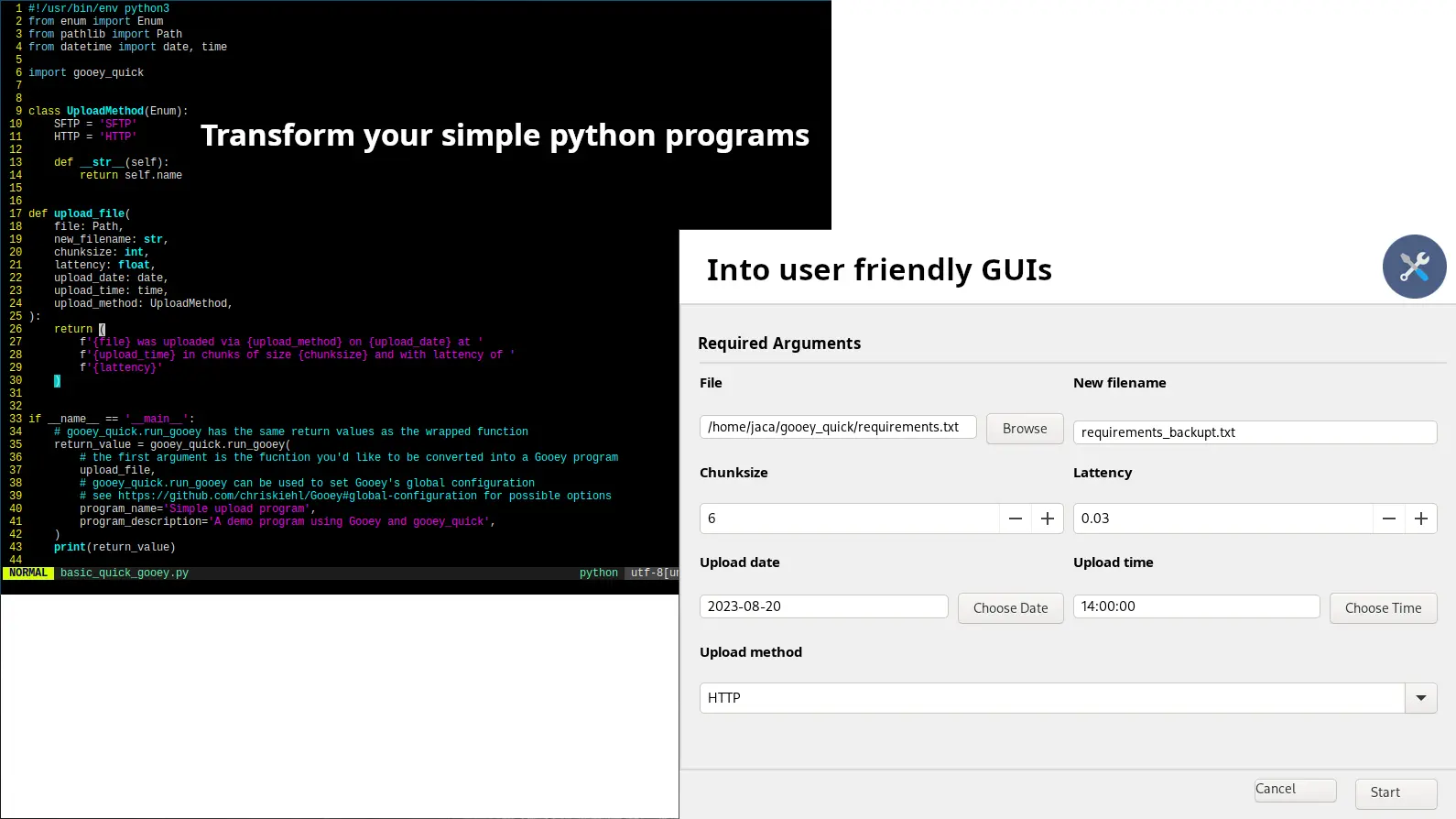Turn type-hinted Python program into a GUI application with few additional lines of code
Project description
gooey-quick
Turn type-hinted Python program into a GUI application with few additional lines of code
Table of contents
Quick Start
Installation
You can install gooey-quick via pip:
pip install gooey-quick
or by cloning the repository directly:
git clone https://github.com/jacadzaca/gooey_quick.git && ./setup.py
Usage
You can integrate gooey-quick with your code as easily as so:
import gooey_quick
def some_function_you_want_to_gooeyfiy(
name: str,
repeat_count: int,
):
for _ in range(repeat_count):
print(f'Hello {name}')
if __name__ == '__main__':
gooey_quick.run_gooey(some_function_you_want_to_gooeyfiy)
Gooey global configuration
You can set Gooey's global options
by setting them in the call to gooey_quick.run_gooey like so:
import gooey_quick
def some_function_you_want_to_gooeyfiy(
name: str,
repeat_count: int,
):
for _ in range(repeat_count):
print(f'Hello {name}')
if __name__ == '__main__':
gooey_quick.run_gooey(
some_function_you_want_to_gooeyfiy,
program_name='Simple demo program',
program_description='A demo program using Gooey and gooey_quick',
)
What is it?
gooey-quick is a library that generates a Gooey-based GUIs from methods' signatures.
Why is it?
A lot of GUI programs that are written in an office setting are wrappers around simple python code. Handcrafting GUIs can be cumbersome, while dealing with argparse-like interface becomes more annoying as the program grows (e.g. you have 6 tabs in your Advanced layout Gooey program). With gooey-quick you should forget about the above and focus on the programs' features.
How does it work?
gooey-quick uses python's built-in typing and introspection functionalities to analyze objects' signatures and generate a fancy GUI using the amazing Gooey by chriskiehl.
Examples
Simple 'Flat layout' application
#!/usr/bin/env python3
from enum import Enum
from pathlib import Path
from datetime import date, time
import gooey_quick
class UploadMethod(Enum):
SFTP = 'SFTP'
HTTP = 'HTTP'
def upload_file(
file: Path,
new_filename: str,
chunksize: int,
lattency: float,
upload_date: date,
upload_time: time,
upload_method: UploadMethod,
):
assert type(upload_method) is UploadMethod
return (
f'{file} was uploaded via {upload_method.name} on {upload_date} at '
f'{upload_time} in chunks of size {chunksize} and with lattency of '
f'{lattency}'
)
if __name__ == '__main__':
# gooey_quick.run_gooey has the same return values as the wrapped function
return_value = gooey_quick.run_gooey(
# the first argument is the fucntion you'd like to be converted into a Gooey program
upload_file,
# gooey_quick.run_gooey can be used to set Gooey's global configuration
# see https://github.com/chriskiehl/Gooey#global-configuration for possible options
program_name='Simple upload program',
program_description='A demo program using Gooey and gooey_quick',
)
print(return_value)
Start Gooey in Advanced mode with 3 different tabs:
#!/usr/bin/env python3
from pathlib import Path
from typing import Optional
from datetime import date, datetime
import gooey_quick
def search_history(
history_file: Path,
wanted_phrase: str,
min_occure_date: Optional[date] = None,
max_occure_date: Optional[date] = None,
) -> Optional[tuple[date, str]]:
occurance_date = date(year=2002, month=7, day=22)
the_phrase = "wow you have discovered my secret phrase!"
occurance_in_range = True
if min_occure_date is not None and max_occure_date is not None:
print(f'Looking for {wanted_phrase} from {min_occure_date} to {max_occure_date}...')
occurance_in_range = occurance_date in range(min_occure_date, max_occure_date)
if wanted_phrase in the_phrase and occurance_in_range:
return f'{occurance_date}: {the_phrase}'
def append_to_history(
history_file: Path,
phrase: str,
occurance_date: date = datetime.now().date()
):
return f'Appending {phrase} to {history_file} at {occurance_date}...'
def remove_from_history(
history_file: Path,
phrase: str,
):
return f'Removing {phrase} from {history_file}...'
if __name__ == '__main__':
# when passing a dict to gooey_quick.run_gooey, the keys become
# the tabs descriptions, while the values are the function to
# create the gui from
return_value = gooey_quick.run_gooey(
{
'Add phrase': append_to_history,
'Remove phrase': remove_from_history,
'Search phrases': search_history,
},
# set Gooey's global config as per: https://github.com/chriskiehl/Gooey#layout-customization
navigation='TABBED',
program_name='Gooey subparser layout from function dict',
program_description='Presents how to create a bundeled configuration with gooey_quick',
)
print(return_value)
For more see the docs/examples/ directory.
Packaging
Please refer to either the official guide or this tutorial
Project details
Release history Release notifications | RSS feed
Download files
Download the file for your platform. If you're not sure which to choose, learn more about installing packages.
Source Distribution
Built Distribution
File details
Details for the file gooey-quick-1.0.1.tar.gz.
File metadata
- Download URL: gooey-quick-1.0.1.tar.gz
- Upload date:
- Size: 12.2 kB
- Tags: Source
- Uploaded using Trusted Publishing? No
- Uploaded via: twine/4.0.2 CPython/3.11.6
File hashes
| Algorithm | Hash digest | |
|---|---|---|
| SHA256 | dd4fc9e344c2f3210498d5b0ecf90d734309c83d002c866cda5bdf18820cdb7a |
|
| MD5 | 7f27b3e8db86603e64e25974732782f1 |
|
| BLAKE2b-256 | 64c5eb1f976d46c25b3327aa363646a559d8ca61530fcbcda8fb92798a109b82 |
File details
Details for the file gooey_quick-1.0.1-py3-none-any.whl.
File metadata
- Download URL: gooey_quick-1.0.1-py3-none-any.whl
- Upload date:
- Size: 9.1 kB
- Tags: Python 3
- Uploaded using Trusted Publishing? No
- Uploaded via: twine/4.0.2 CPython/3.11.6
File hashes
| Algorithm | Hash digest | |
|---|---|---|
| SHA256 | fdcee4c14109490df7abc85ff275490140f5bd8bb64916245fdefe88288428e9 |
|
| MD5 | 5f053bc444a1d2d54ef21281c0c9684a |
|
| BLAKE2b-256 | 689f32791b7cece6507b1cfb03155760bdc423642dd4a2b62d7e3057571ed8cd |












